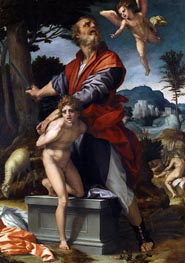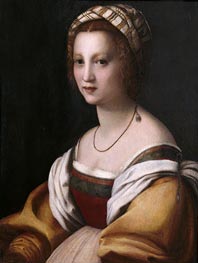
Andrea del Sarto Giclée Fine Art Prints
1486-1530
Italian Renaissance Painter
Andrea del Sarto is often seen as the quiet genius of the Renaissance - a figure whose talent was immense but whose renown has long been overshadowed by his contemporaries. Born in Florence in 1486, Andrea was called “senza errori” - without errors - a testament to his technical prowess, his command over form, light, and color. Yet for all his skill, his story is one of subtlety rather than spectacle. There is an understated elegance to his work, a calm amidst the vibrancy of the Renaissance, which both defines and complicates his legacy.
Andrea’s early years, shaped by the artisan culture of Florence, saw him first apprenticed to a goldsmith and later trained under Piero di Cosimo. It’s easy to trace this artisan precision in his later work - his figures are meticulously composed, his brushwork finely tuned. By the time he collaborated with Franciabigio on frescoes for SS Annunziata in Florence, Andrea had already begun to distinguish himself. His frescoes from this period, particularly the "Nativity of the Virgin" (1514), showcase his ability to blend clarity with tenderness. There’s a softness in his treatment of light and an emotional nuance to his figures that sets him apart from his more theatrical contemporaries.
In the trajectory of his career, Andrea’s brief sojourn in France is often regarded as a pivotal point. Invited by Francis I in 1518, this could have been his moment of international fame, yet his stay was short-lived. Vasari’s tale - that Andrea misused the King’s funds and returned to Florence never to be invited back - has long shaped his reputation. Whether or not this story holds truth, it reflects the complexity of Andrea’s character as an artist. His loyalty to Florence, his modest ambitions, and his personal life - especially his relationship with his wife Lucrezia - all seem to play into a narrative of quiet domesticity that contrasts sharply with the larger-than-life figures of Michelangelo or Leonardo.
Andrea’s art reflects this tension. Take, for instance, the "Madonna of the Harpies" (1517). At first glance, it follows the traditional forms of High Renaissance painting - the pyramidal composition, the graceful gestures, the serene Madonna. But there’s a stillness here that feels introspective, almost contemplative. It lacks the grand theatricality of Michelangelo’s work or the ethereal experimentation of Leonardo. Instead, Andrea offers something deeply human - a focus on balance, harmony, and the inner life of his figures.
His later works, such as the "Last Supper" at San Salvi, demonstrate a maturity of vision. Painted in 1527, just a few years before his death in 1530, this fresco reveals a more relaxed, almost intimate approach to religious scenes. His figures are imbued with individuality, their expressions reflective, not grandiose. And it is here, perhaps, that we see Andrea’s true legacy: a painter of quiet depth, whose technical mastery was always in service of a more intimate, nuanced vision of human experience.
Though his life was cut short by the plague, Andrea del Sarto’s body of work continues to invite reflection. His is a quieter brilliance - one that may not shout from the rooftops, but hums with a resonance that lingers long after you’ve looked away.
Andrea’s early years, shaped by the artisan culture of Florence, saw him first apprenticed to a goldsmith and later trained under Piero di Cosimo. It’s easy to trace this artisan precision in his later work - his figures are meticulously composed, his brushwork finely tuned. By the time he collaborated with Franciabigio on frescoes for SS Annunziata in Florence, Andrea had already begun to distinguish himself. His frescoes from this period, particularly the "Nativity of the Virgin" (1514), showcase his ability to blend clarity with tenderness. There’s a softness in his treatment of light and an emotional nuance to his figures that sets him apart from his more theatrical contemporaries.
In the trajectory of his career, Andrea’s brief sojourn in France is often regarded as a pivotal point. Invited by Francis I in 1518, this could have been his moment of international fame, yet his stay was short-lived. Vasari’s tale - that Andrea misused the King’s funds and returned to Florence never to be invited back - has long shaped his reputation. Whether or not this story holds truth, it reflects the complexity of Andrea’s character as an artist. His loyalty to Florence, his modest ambitions, and his personal life - especially his relationship with his wife Lucrezia - all seem to play into a narrative of quiet domesticity that contrasts sharply with the larger-than-life figures of Michelangelo or Leonardo.
Andrea’s art reflects this tension. Take, for instance, the "Madonna of the Harpies" (1517). At first glance, it follows the traditional forms of High Renaissance painting - the pyramidal composition, the graceful gestures, the serene Madonna. But there’s a stillness here that feels introspective, almost contemplative. It lacks the grand theatricality of Michelangelo’s work or the ethereal experimentation of Leonardo. Instead, Andrea offers something deeply human - a focus on balance, harmony, and the inner life of his figures.
His later works, such as the "Last Supper" at San Salvi, demonstrate a maturity of vision. Painted in 1527, just a few years before his death in 1530, this fresco reveals a more relaxed, almost intimate approach to religious scenes. His figures are imbued with individuality, their expressions reflective, not grandiose. And it is here, perhaps, that we see Andrea’s true legacy: a painter of quiet depth, whose technical mastery was always in service of a more intimate, nuanced vision of human experience.
Though his life was cut short by the plague, Andrea del Sarto’s body of work continues to invite reflection. His is a quieter brilliance - one that may not shout from the rooftops, but hums with a resonance that lingers long after you’ve looked away.
2 Andrea del Sarto Artworks

Giclée Canvas Print
$58.34
$58.34
SKU: 16839-DSA
Andrea del Sarto
Original Size:98 x 69 cm
Prado Museum, Madrid, Spain
Andrea del Sarto
Original Size:98 x 69 cm
Prado Museum, Madrid, Spain

Giclée Canvas Print
$62.26
$62.26
SKU: 16840-DSA
Andrea del Sarto
Original Size:73 x 56 cm
Prado Museum, Madrid, Spain
Andrea del Sarto
Original Size:73 x 56 cm
Prado Museum, Madrid, Spain